Contributed by Offaly History with water colours courtesy of Fergal MacCabe
Township could be said to have begun in Tullamore in 1622. On 30 September the anniversary will be marked with an outdoor exhibition of drawings by Fergal MacCabe and a Timeline of Events showing the story of the town since the earliest times. We have covered many stories of Tullamore in over 420 blogs published in this series. All can be accessed on www.offalyhistory.com. For a quick link to all these resources see @offalyhistory
[Offaly Heritage Office writes on 24 9 2022]
Offaly Heritage identifies the wonderful engaging blogs by Offaly History outlining how the town of #Tullamore has developed.
Join us on Friday 30th in Millennium Square, Main Street, to see #OffalyHistory blogs presented in a picturesque timeline to celebrate #Tullamore400. We have entertainment from 2pm to 6pm in association with Up Close & Personal Promotions with thanks to the Department of Tourism, Culture, Arts, Gaeltacht, Sport and Media for their #LocalLivePerformance support.
Visit Offaly Tullamore Chamber
#Offaly #SpaceToExplore #SpaceToGrow
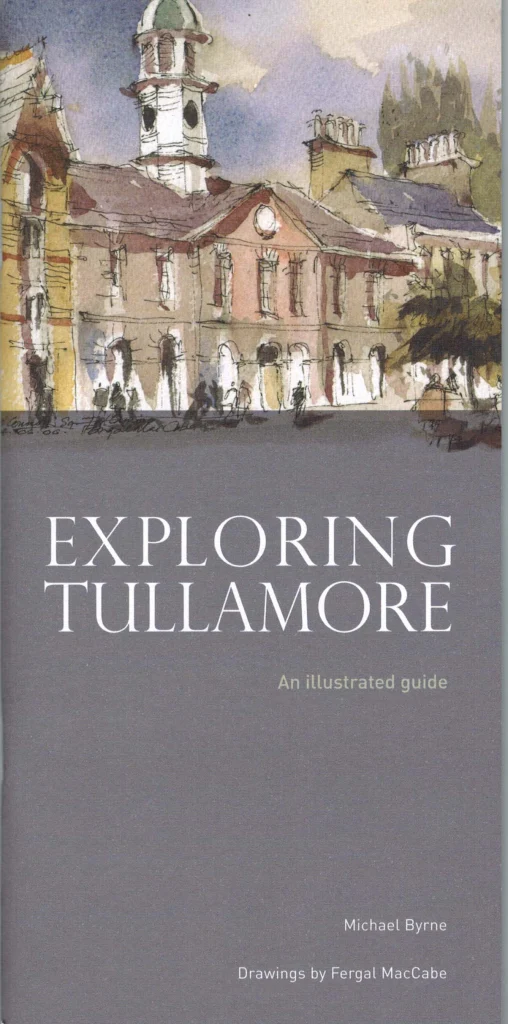
Much of the early growth of Tullamore was due to the extension of the Grand Canal to the town in 1798 and later to expansion in distilling and milling. The town is associated with Tullamore DEW, the famous Irish whiskey for over 100 years and a distilling history in excess of 200 years. Now it is home to the Tullamore Dew Distillery situated in a green field site on the Tullamore bypass. The former visitor centre beside the Grand Canal at Bury Quay was in a bonded warehouse erected in 1897. This was closed in 2020. Tullamore is also associated with Irish Mist, the world class liqueur.
Tullamore is a well-preserved town providing an example of provincial town planning in some of its best moments. The streets are spacious and the houses, several of which date from the 1740s, are well finished.
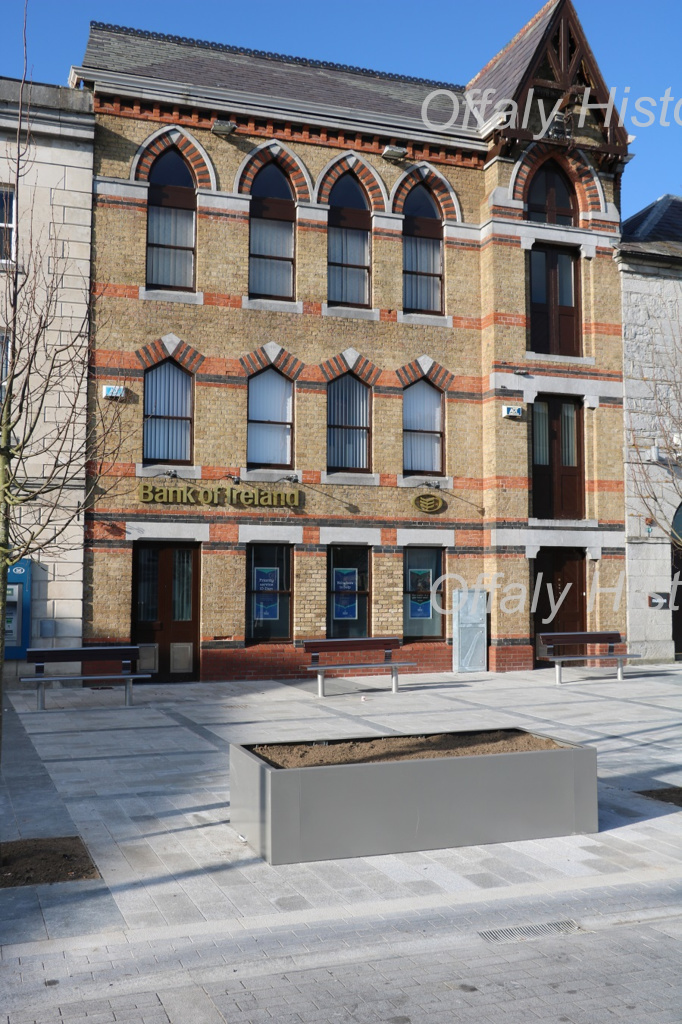
The principal town square, known as O’Connor Square, was improved in recent years and includes an attractive market house dating from 1789 and erected by the then owners of the town, the earls of Charleville. Nearby is a restored Victorian brick warehouse façade of 1871 (see an earlier blog) now incorporated in the Bank of Ireland. The town library at the eastern end of O’Connor Square occupies the site of the house where W.B. Yeats’ ancestors were married in 1773.

On the western side of the square is the Bridge Shopping Centre, built with a nod to the town’s architectural style. To the right of the Centre is the distinctive Bridge House which now incorporates the new Bridge House Hotel of 1999. It got a new Tullamore cut stone façade in 1910, courtesy of P.& H. Egan. At Cormac Street (on the Birr Road) and close to the railway station is the county courthouse, arguably the most important building in Tullamore and built in the neo-classical style in 1835. It was designed by the architect J.B. Keane and one of its two semicircular courtrooms has survived. The courthouse was rebuilt in 1927 after its burning in the civil war and refurbished and enlarged in 2007. Beside it is a Gothic style gaol (now Kilcruttin Business Park) built in 1826-30. It was officially discontinued as a county gaol in 1924, having been destroyed in the civil war. One of the last public executions in Ireland took place here in 1865 and the second last woman to be hanged in Ireland went to her death here in 1903. Of the newer style of architecture in Tullamore some of the examples are the Tullamore Court Hotel (1997) at O’ Moore Street, extended in 2006 to over 100 beds and the reconstructed (1986) Church of the Assumption at Harbour Street, Boots Pharmacy (2001) and the Bridge House Hotel (1999). At Charleville Road is the award-winning building of the Offaly County Council offices – Aras an Chontae (2002) and at Ardan Road the new Midland Regional Hospital (2007) close to the important Scott and Good hospital of the 1930s. About a mile from the town centre is the wonderful Gothic castle of architect, Francis Johnston, known as Charleville Forest, set in the largest extent of oak woods in Offaly, Charleville Demesne, and with the famous ‘King Oak’ at the entrance to the demesne. Also of great interest is the town park completely redesigned in 2008 in a contemporary style, but with historical set pieces such as Kilcruttin cemetery where members of the King’s German Legion are buried and Tullamore’s Famine victims of 1845-9. In the grounds of the park and close to the skate board attraction is a monument to Irish ex-service men and women and erected in 1986. On the hill is the recently restored Acres Folly built to commemorate British victories in the Peninsular Wars in which many Irishmen fought. The folly is in the garden of Acres Hall – the house built by Thomas Acres in 1786 and remodelled in 1992 for the town council.
Tullamore Dew Distillery
Tullamore is famous for its whiskey, ‘Tullamore Dew’ and earlier for its Irish Mist liqueur. The TullamoreDew Distillery recounts the role of distilling in the town’s development and the impact of the Grand Canal transport system. After the visit a courtesy taste of Tullamore DEW is provided. In 2010 ownership of the brand passed to Grants as part of a €300m deal. For further information see www.tullamoredew.com and www.tullamore-dew.org. The distillery is on the bypass in a green field site.
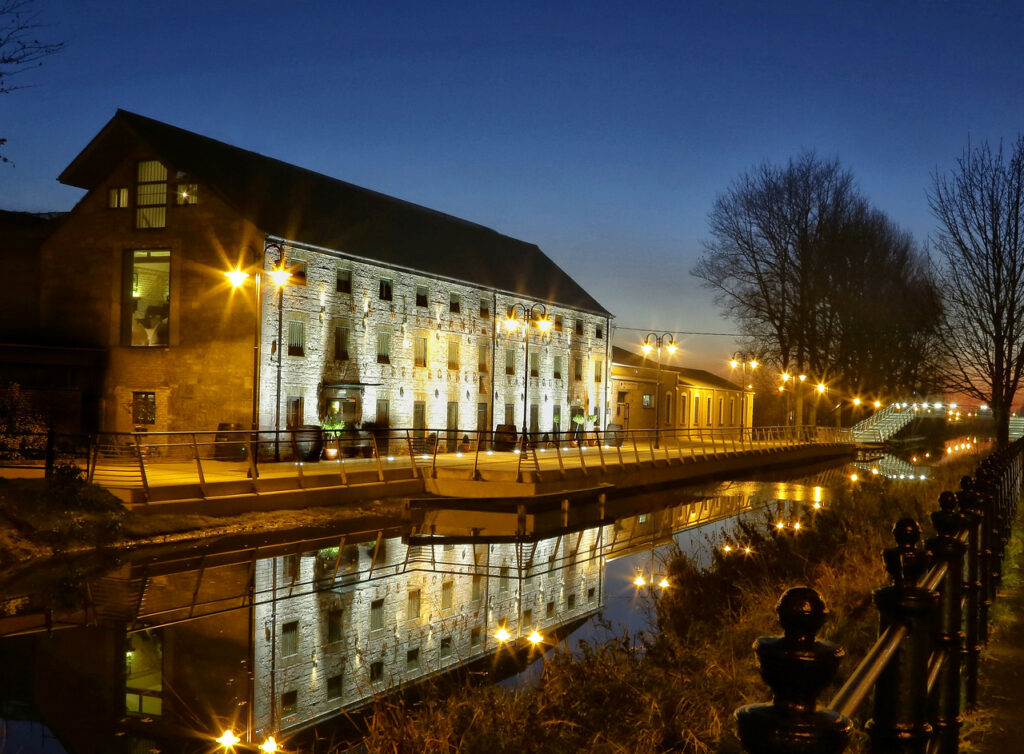
Offaly History Centre (info@offalyhistory.com)
The Offaly History Centre is situated at Bury Quay, Tullamore www.offalyhistory.com incorporates the Laois/Offaly Family History Centre known as Irish Midlands Ancestry. It is the home of the Offaly Historical and Archaeological Society (founded 1937 and reformed in 1969) and contains an extensive collection of material relating to the archaeology and history of the county. The building, once a wine warehouse, now contains much of interest to historians of County Offaly with some 25,000 books and some 300,000 photographs. Exhibitions are frequently held at the centre. A public reading room is available by appointment and an extensive array of local studies and copies of old photographs are offered for sale. The Society provides a website where access to over 5,000 items of history is available free and is regularly updated. This includes the new Decade of Centenaries platform with free articles and stores to consult. Lectures and other events are held monthly. The Society’s history for sale collection now extends to over 3,000 volumes and its library to 25,000 volumes.
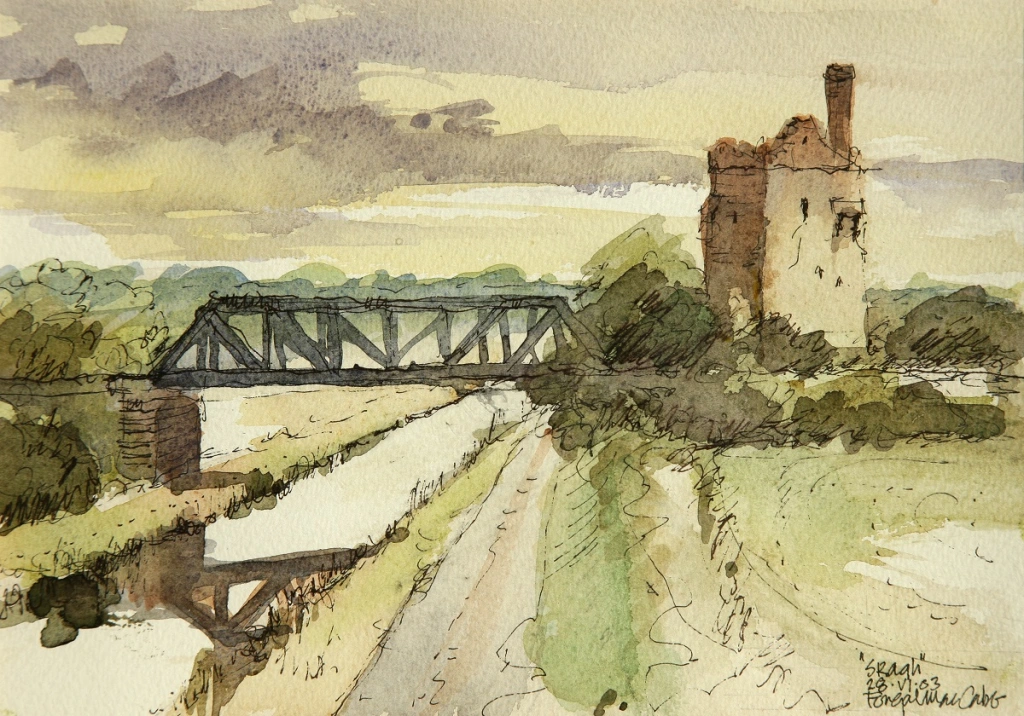
Offaly County Library at O’Connor Square
This 1930s centrally situated building has an important local history collection that is readily available during library opening hours.
Offaly Archives
A new county archives was opened fully in 2022 (after Covid) and its services are provided by Offaly History in cooperation with Offaly County Council. Consult www.offalyarchives for more information.
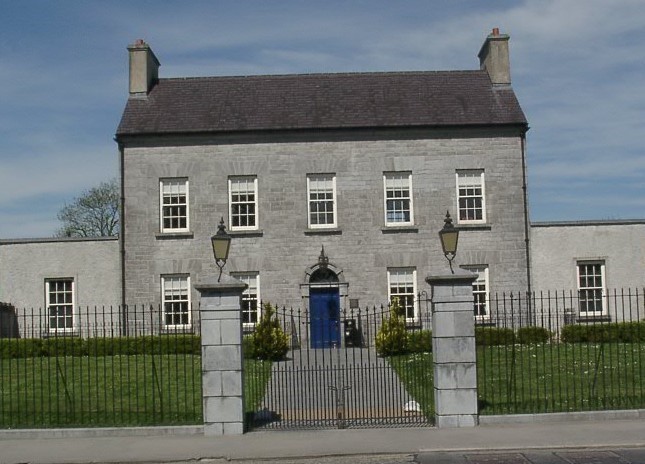
St Catherine’s Church of Ireland church
This is one of the finest of the Protestant churches in the diocese and was designed by Francis Johnston, the architect of Charleville Forest house. The church was completed in 1815 and is situated on Hop Hill, a natural mound near the town. The building is not usually open outside of services. Inside is the fine monument to Charles Moore, first earl of Charleville, (died 1764) by John Van Nost, the younger. In the crypt, now sealed off, are the coffins of the Burys of Charleville from Charles William (died 1835) to Colonel Bury of Mount Everest fame of 1963. Most pathetic is the small coffin to Lady Harriet, the child of eight who was killed on the stairs at Charleville in 1861. Her parents were both dead and she was in the care of her uncle, Alfred Bury. Also in the church are memorials to parishioners who served and died in the First World War, some members of the Bury family and several rectors.
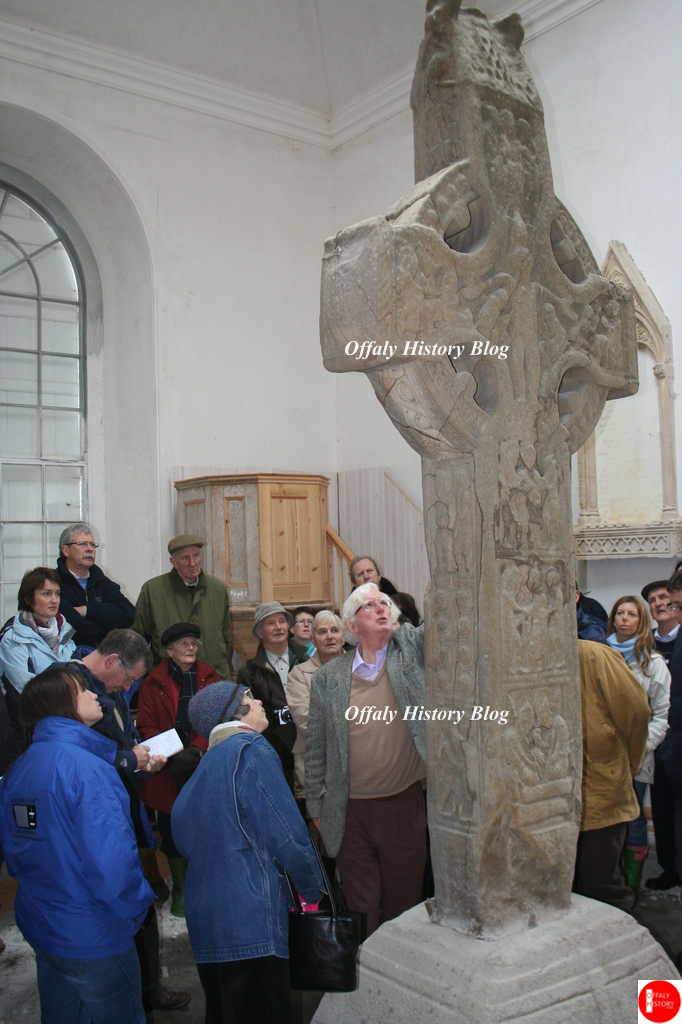
Tullamore Catholic Church
Tullamore Catholic Church was destroyed by fire in 1983 with the exception of the bell tower and steeple. The new church (1986) has a fine interior and is of architectural interest for its steeply pitched timber structure portal frames and ceiling. The building was designed by Edward Smith and Partners, architects. The exterior of the church is somewhat unsuccessful and was compromised by the desire to retain parts of the old church and the tower and steeple. On the other hand as one commentator noted of the interior:
It is a breathtaking feat of engineering with soaring cruck-arches in laminated wood supporting the side aisles and reaching on upwards into the clerestory to support the roof. The potential for beauty inherent in mathematically inspired structures, often reserved for bridges, is here applied to a church. The feeling of space is uplifting and the furnishings are of consistently high quality (Lawrence, 2009).
There are some six windows from the Harry Clarke Studios and designed by Clarke and also contemporary stained glass. The large windows in the new church of 1986 are by Dublin Glass and Paint Company and were executed for Tullamore while almost all the others were brought from elsewhere including the Harry Clarke designed windows which had originally been in Rathfarnham Castle. The church also houses one of the largest organs in Ireland – a gift from Copenhagen. Books on the church which marked the rebuilding in 1986 and its centenary in 2006 are available in local bookshops or from the Offaly Historical and Archaeological Society. The interesting study (Lawrence, 2009) of the windows of the church and others in the county can be viewed in OHAS and the Offaly County Library.
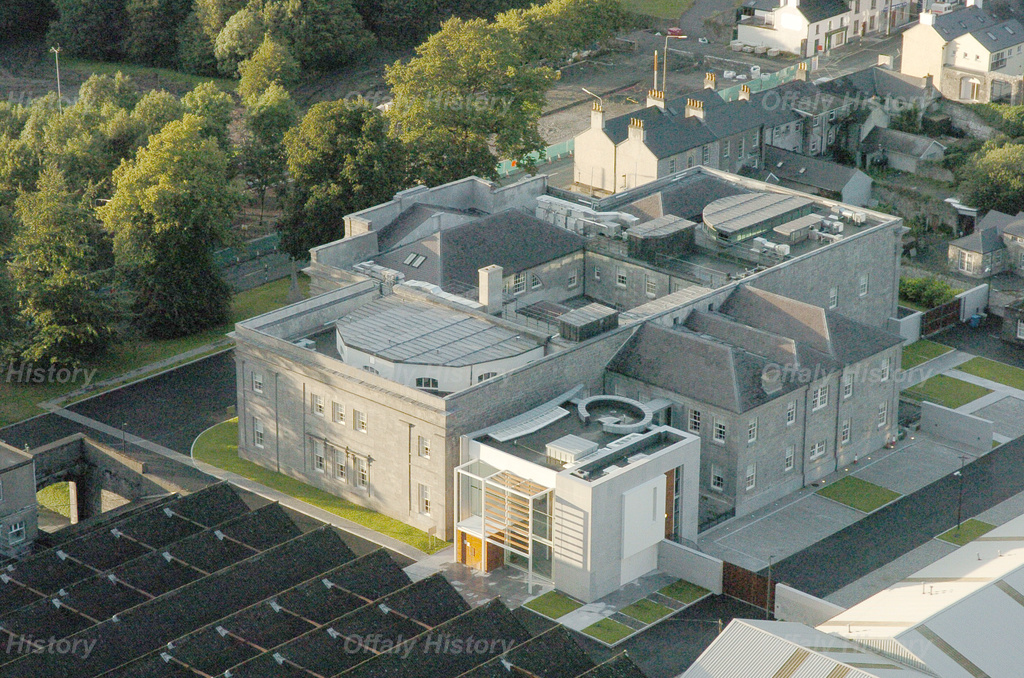
Charleville Castle/Forest
Charleville castle, or more correctly Charleville Forest, was designed by Francis Johnston and its builder, Charles William Bury, first earl of Charleville. It is open to the public by appointment and is considered to be one of the finest Gothic houses in Ireland. The fairy tale style castle was designed in 1798 and completed over the years 1800 to 1812. This magnificent building was vacant from about 1912 to 1970. The main rooms with their spectacular ceilings have for the most part survived the years of lying empty. The castle is now lived in again and an attempt is being made to preserve and restore it to its former glory. From the tall circular tower can be seen the four neighbouring counties. Charleville demesne includes the best extent of surviving oak wood in Offaly. Its avenues offer some of the finest walks near Tullamore matched only by the tow paths of the Grand Canal. The ‘King Oak’ near the entrance gate from Tullamore may date back to 1482 or earlier and is featured in Thomas Pakenham’s choice of some sixty notable trees of Britain and Ireland. County Offaly with Waterford and Wicklow have now the greatest extent of surviving native woodlands. The walks in the demesne are open to the public courtesy of the Hutton Bury family. All that is requested is that visitors respect the beautiful grounds and keep to the footpaths.
Charles William Bury commenced building his castle in 1801 and completed the job in 1812. Perhaps ‘in deference to the oak trees he called his house not Charleville castle but Charleville Forest already there was one giant tree known as the ‘King Oak’ dominating like a watch tower’. No one knows who planted the tree – king or peasant – or whether it sowed itself. But it seems to be a descendant of the great forests of common oak (Quercus robur) that once straddled the soggy green plains of central Ireland. Estimates of its age begin at 400 years; it might be double that. With a girth of 26 feet below its lowest branches, it is one of the oldest, largest and best-preserved oaks in the country and is said to date from 1482. The Bury family believed that if a branch fell, one of the Burys would die, so they supported the great arms with wooden props. Of course there was nothing they could do to protect the trunk. In May 1963 a thunderbolt splintered the main trunk from top to bottom. The tree survived, but the head of the family, Colonel Charles Howard-Bury, (famous for his Everest climb and ‘Abominable Snowman’) dropped dead a few weeks later (see Thomas Pakenham, Meetings with remarkable trees (London, 1996), pp 26-27.
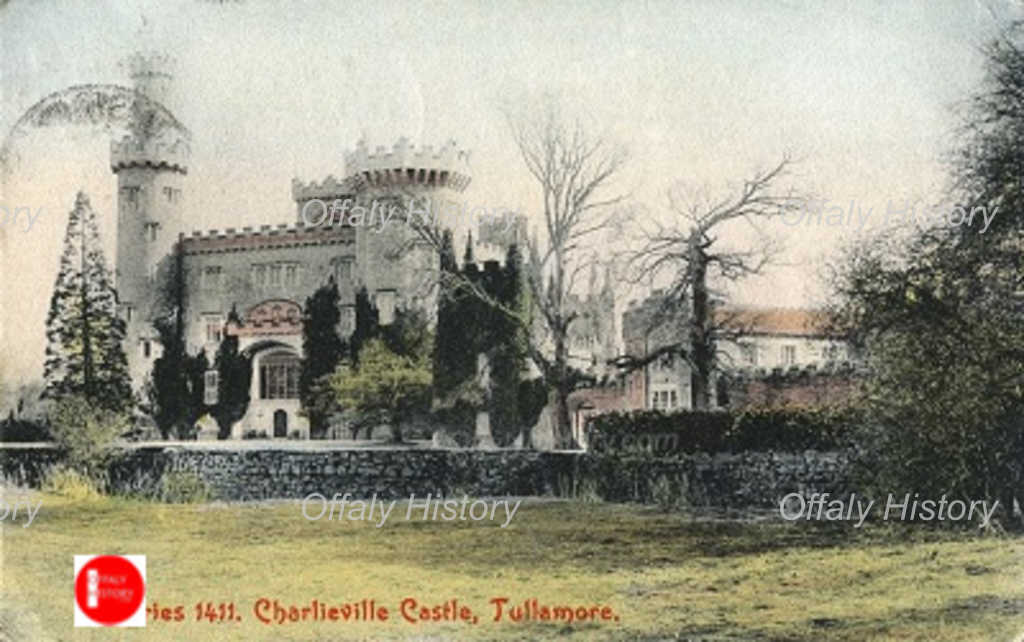
Others think the ‘King Oak’ may be as much as 900 years old, ‘but it has not been ring-counted and this may be a fanciful estimate; if the estimated age is correct, the King Oak would be a worthy candidate for the oldest living plant in Ireland’ (see E. Charles Nelson and Wendy Walsh, Trees of Ireland (Dublin, 1993), p. 125.
Tullamore people have a story that local property developer, Thomas Acres, made a bet that he knew a tree in Tullamore that covered ‘five acres’. Wagers were offered and lost when Acres placed his five sons under the great tree!
Town Walk and App
A walk about the town can take 30 mintues up to three hours, but is well worth the time taken exploring the historic centre which includes St Catherine’s church, Kilcruttin cemetery in the town park and the old streets dating from the mid to late eighteenth century. A walk along the canal, Charleville or around Collins Lane and Srah to Kilcruttin and Cormac Street offers respite from shopping and traffic and, in addition, provides healthy exercise. Much of Tullamore: a Portrait book is given over to exploring the streets with a view to informing a leisurely stroll. A free online guide to Tullamore is available to download from www.offalyhistory.com and is in several languages
Durrow Abbey, High Cross and Early Christian Slabs: a beautiful ninth-century High Cross, early Christian slabs and St Columcille’s holy well can be viewed about three miles outside Tullamore on the Kilbeggan road (N52). A monastery was founded here by Columcille in the mid-sixth century. The seventh-century illuminated manuscript, the Book of Durrow, can be seen in Trinity College, Dublin and was in the Durrow monastery until the mid-seventeenth century. Unlike Kells there is no clamour to ‘bring the book home’ and instead local energy was devoted to having public access as of right secured and the place made presentable to the public in place of the Gothic ruined appearance of the 1990s much commented on in the Rough Guide to Ireland at the time. Durrow Abbey house dates from the 1830s and is owned by the State. The house was destroyed by the IRA in the early 1920s and rebuilt in 1926–7 at a cost of almost £40,000 for Otway Graham Toler by Duffy Brothers, Tullamore in the domestic Tudor style. The High Cross was removed to the interior of the eighteenth-century church in 2004 and opened in 2011. The church has now been adapted by the Office of Public Works to hold and exhibit these sculptures so important to the early Christian history of the Tullamore district and to Ireland. The work is done well and the church has been handsomely restored. However, issues of traffic access from the public road are putting the €5m investment at risk and delaying the proper completion of Durrow by the state.
Lord Norbury, son of the ‘Hanging Judge’, was shot here on New Year’s Day 1839 and buried in the days after ‘the Great Wind’ – as if God himself was expressing his anger at this wanton outrage on the rights of property! The second Church of Ireland church at Durrow (1880s) is now a private house but with access to the graveyard retained for the public.
Also in Durrow is the fine Gothic-style Catholic church of 1831 with a substantial graveyard adjoining where many local people and the old worthies of Tullamore are buried. This church has a splendid interior with plaster vaulting and was carefully restored in the early 1990s. On the exterior is a tall tower and its battlements. The corner pinnacles of the church are embellished with crockets or knobs. In the entrance hall is a memorial to Pastor James O’Rafferty, for almost forty years parish priest of Tullamore. O’Rafferty was a man whose support was necessary to gain the local parliamentary seat after 1832 and who did much to secure the coming of the Mercy sisters to Tullamore as their second house after Baggot Street, Dublin. The Stations of the Cross in French terra cotta were made by the artist, Robert de Villers and intended for the church of Cardinal Verdier in Paris. No longer required they came via a Sandymount church to the Jesuit community chapel at Tullabeg in the 1940s. After the Jesuits departed from Tullabeg in 1991 the Stations were donated to Durrow, then in course of renovation. More investigation on this is needed.
Tihilly High Cross: three miles outside Tullamore on the Clara road north of Kildangan (not signposted, but opposite the entrance to Coleraine House) is Tihilly Cross. A monastery was founded here in the sixth century. The ruins of a medieval church survive together with a High Cross nearby set in a round base beside an early Christian slab. Access is by permission only from the owners of the land whose dwelling house adjoins the public road immediately to the front of the monastic site. This is a wonderful, quiet and peaceful place, captivating in its simple beauty. The cows grazing nearby and sometimes a bull help to keep the area clean and free of strangling growth. The stream and the pair of ancient ash trees that frame the site add to the beauty of the place. These ash trees are among the oldest in the country and for some are more exciting than the High Cross. This monastic site has lately been the subject of a study as to what is the best for the place in terms of the preservation of the cross and its context.
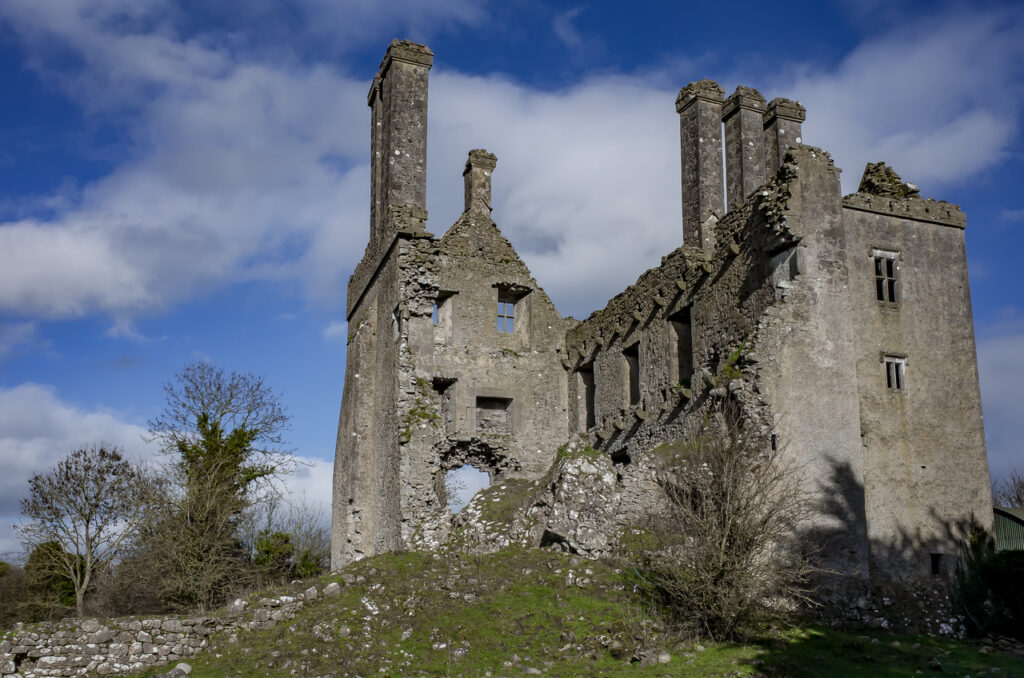
The neighbourhood of Tullamore
In the vicinity of Tullamore are Srah castle, Ballycowan castle, Lynally monastery, Rahan Abbey, Lemanaghan, the shrine of St Manchan at Boher church and the monastery of Clonmacnois. In Mucklagh Catholic church can be seen the former Tullabeg altar of the 1940s designed by Michael Scott and made in native oak with carvings by Laurence Campbell. Further south is the town of Kilcormac with its wonderful 1860s Catholic church, medieval pieta and on the back road from Kilcormac, or via Blue Ball (an old inn), is Boora Lake and Sculpture Park. The latter now has a short and beautiful free guide – Sculpture in the Parklands and a website of the same name. These places are on the route to Birr with its Georgian town, castle and science museum. To the east of Tullamore is the old town of Daingean, called Philipstown until 1920 after Philip II of Spain, and established at the same time as Madrid, but there the similarities end. Here can be seen the former county courthouse and the grave of the saintly Fr Mullen at Kilclonfert. Further east is the extinct volcano, Croghan Hill. It was saved from destruction by a quarry company in 1977 and is well worth a climb. Further east is the town of Edenderry once owned by Lord Downshire with its fine 1830s Market House. If you have detailed queries there is an active historical society here and a number of fine histories published. East of Durrow and north of Tullamore is the monastery of St Hugh at Rahugh and the village of Tyrrellspass. The latter, an estate village, laid out by a lady gifted with ‘a masculine intelligence’, Jane countess of Belvedere. In Kilbeggan is the original Locke’s distillery and nearer to Mullingar, Belvedere House, once owned by Colonel Bury of Charleville Forest, Tullamore. Both Locke’s distillery and Belvedere House are important visitor attractions, open to the public. For Tyrrellspass and Rahugh one can take the old road north of the canal and Whitehall bridge. Attractive guides to the county and to its heritage are available at the Tullamore Tourist Office and Offaly History Centre.
Tullamore’s link with Chandler, Arizona
Tullamore created a special link with the town of Chandler in Arizona in 2009. The link was born of the desire to emulate Chandler as an attractive and vibrant hub for new service industries. The link is cultural too with several representatives of Irish heritage studies in Chandler coming to Tullamore each year.
For further information on Tullamore see the website www.offalyhistory.com also that of Offaly County Council (www.offaly.ie), and Tullamore DEW
Local histories, historical journals, maps and old photographs can be purchased at local bookshops and at the Offaly History Centre, Bury Quay, Tullamore (057 9321421, info@offalyhistory.com). The intelligent and curious visitor who wants to know more can have no excuse in this information-laden age. In the early 1970s there was virtually nothing available on Tullamore history to purchase. Now there is much of Offaly interest, but it serves to highlight the many gaps in historical research waiting to be filled. Recently studies have been undertaken of O’Connor Square and High Street and much of this will be published in due course. Subscribe to Offalyhistoryblog to be updated and better still become a member of Offaly Historical and Archaeological Society for €30 a year.
